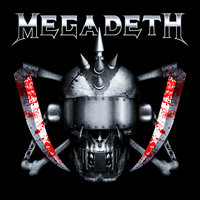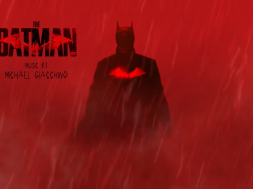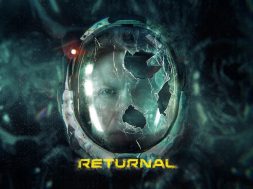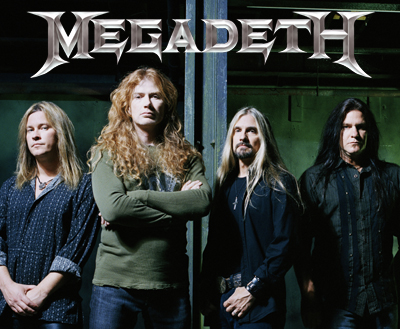
With news that metal elder statesmen Megadeth have recently put the finishing touches on their latest salvo of rhythm-and-riffs “Super Collider” (due June 30th via Tradecraft/Universal, available to pre-order on Amazon now, and the subject of a preview you can read on this site soon) there’s no better time to comb over the band’s rather extensive back catalog – so extensive there’s not room to fit in any of the b-side collections, side projects or the myriad live recordings – and look back at the successes, the experiments, the gems and the missteps on a career path that’s spanned almost 4 decades, approximately 8 different recorded lineups and 40 million albums sold worldwide.
PART 1 – Fast, Loud & Rude
Killing Is My Business…And Business Is Good! (Combat, 1985)
What’s often forgotten about Megadeth’s debut, amid the light-speed playing and grimy, in-your-face attitude is just how bloody WEIRD it is. With thrash metal still in its infancy, it would be a few years before the likes of Metallica and Anthrax would begin experimenting on their albums (even Slayer would move outside the thrash pigeonhole a little), but in 1985 those bands and their lesser peers were sticking to the template. Not so for Megadeth and Dave Mustaine who, fuelled by his own much-documented jealousies and backed by a band featuring jazz virtuosos Chris Poland and Gar Samuelson, produced one of the most unique albums of the period, and a proper thrash curio.
From the classical piano intro of “Last Rites/Loved To Deth”, to the Monty Python-themed “Chosen Ones”, the stomping funk-metal of “Looking Down The Cross” which does musically what The Last Temptation Of Christ did in film form and the mischeivous re-imagining of Nancy Sinatra on the “These Boots” cover, there’s more musical diversity and innovation on offer here than would be found in most albums in general, much less 80s metal. There’s potential for things to get self-indulgent, but the whole thing is played with such energy that it all whips by at a thrilling breakneck pace, held together by a balls-to-the-wall metal spine – Skull Beneath The Skin packs more riffs into 5 minutes than some metal bands have in entire albums. Straight metal songs like Rattlehead and The Mechanix burn with youthful drive and party atmosphere and help carry the more avant garde elements over to make for a sonic assault with plenty of enjoyment to be had on repeat listen.
The production is rough as a bag of badgers and the less said about the album art the better, but this is nevertheless a truly unique and arresting record, and one of the finer moments in the history of thrash metal.
Peace Sells…But Who’s Buying? (Capitol/EMI, 1986-87)
After jumping to Capitol Records from Combat after a number of production issues cropped up during the recording of the follow up to Killing Is My Business (basically the mix was horrible) Megadeth took its first steps towards becoming the business machine it would eventually evolve into, losing some of its more abstract elements in favour of a more controlled approach.
Aside from a spitfire cover of blues standard I Ain’t Superstitious and the iconic bass intro of the anthemic title track, Peace Sells is a significantly more straightforward affair than its predecessor, curtailing the experimentation of their debut and focusing purely on high speed thrash metal played with tons of attitude to go with its big-label production.
The end result is one of the most celebrated metal records in history, a pulse-pounding collection of guided-missile riffage, screeching solos, and Dave Mustaine’s cynical and often pain-filled vocals (owing more than a small debt to Alice Cooper). Songs like Devil’s Island, The Conjuring and the Iron Maiden-esque My Last Words offer brutal intensity in spades, while the likes of Wake Up Dead and Good Mourning/Black Friday draw their power from precise pace-changes (the former’s chant-along end riff) and brooding atomsphere (the eerie opening of Good Mourning) creating chilling counterpoints to the full-on face-melting brilliance of it all.
If there is a drawback to the record, it would be Mustaine’s Marmite singing, which would become a divisive topic among metal for a long time afterwards, but its a moot point in the face of the quality of everything else. Where Killing… was scattershot and scatterbrained, here the intensity is channelled and directed straight at the listener.
A masterpiece.
So Far, So Good…So What? (Capitol/EMI, 1988-89)
Coming during a troubled period in the band’s history – Samuelson and Poland were replaced by Chuck Behler and Jeff Young, producer Paul Lani was ousted during mixing for Michael Wagener (fresh from mixing Metallica’s Master Of Puppets, fact fans) amid clashes with Mustaine over the recording methods – this album shows the scars of the turbulence and rock star excess that surrounded its creation.
The production takes a major dive in quality (even the 2004 remastered release sounds rough) and the musical exploration returns, this time with mixed success. The horn sections on instrumental “Into The Lungs Of Hell” provides thrills, while the KISS-referencing audio car-chase of “502” – a song about traffic tickets that’s better than that might sound – grates thanks to its awkward placing in the middle of the song.
But neither these nor the rest of the tracks is helped by the over-indulgence that plagues the album. Closer “Hook In Mouth” is about two minutes too long, and the awkward, garbled version of the Sex Pistols’ “Anarchy In The UK” was the last cover to make it onto a Megadeth record until the Hidden Treasures B-side collection some 10 years later. The band, despite being energetic, don’t gel in the same fashion as the previous lineup, and there are moments that feel hacked together in a desperate attempt to save the squandered budget for the record.
In spite of its failings, however – and in some ways because of them – So Far, So Good… still offers plenty of moments to make it worth a listen. “Set The World Afire” is blistering, dark and muscular in equal measure and the eerie tempo shifting Mary Jane show’s the new lineups’ potential to good effect, full of evocative (if far from perfect) musicianship. But it’s In My Darkest Hour that stands out of the crowd, a heart-rending musical journey that burns with rage and sadness, with the type of cathartic denouement that Megadeth have long delivered so well. Messy it may be, but So Far, So Good…So What? is never less than compelling music.












